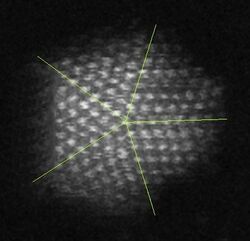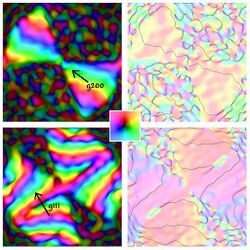Physics:Icosahedral twins


An icosahedral twin is a nanostructure appearing in atomic clusters and also nanoparticles with some thousands of atoms. These clusters are twenty-faced, with twenty interlinked tetrahedral crystals joined along triangular (e.g. cubic-(111)) faces having three-fold symmetry. A related, more common structure has five units similarly arranged with twinning, which were known as "fivelings" in the 19th century,[1][2][3] more recently as "decahedral multiply twinned particles", "pentagonal particles" or "star particles". A variety of different methods (e.g. condensing argon, metal atoms, and virus capsids) lead to the icosahedral form at size scales where surface energies are more important than those from the bulk.
Causes
When interatom bonding does not have strong directional preferences, it is not unusual for atoms to gravitate toward a kissing number of 12 nearest neighbors. The three most symmetric ways to do this are by icosahedral clustering, by crystalline face-centered-cubic (cuboctahedral) and hexagonal (tri-orthobicupolar) close packing.
Icosahedral arrangements, typically because of their smaller surface energy,[4] may be preferred for small clusters. However, the Achilles' heel for icosahedral clustering is that it cannot fill space over large distances in a way that is translationally ordered, so there is some distortion of the atomic positions, that is elastic strain.[4] De Wit pointed out that these can be thought of in terms of disclinations,[5] an approach later extended to 3D by Yoffe.[6] The shape is also not always that of a simple icosahedron,[3] and there are now several software codes that make it easy to calculate the shape.[7][8]
At larger sizes the energy to distort becomes larger than the gain in surface energy, and bulk materials (i.e. sufficiently large clusters) generally revert to one of the crystalline close-packing configurations. In principle they will convert to a simple single crystal with a Wulff construction[9] shape. The size when they become less energetically stable is typically in the range of 10-30 nanometers in diameter,[10] but it does not always happen that the shape changes and the particles can grow to millimeter sizes.
Ubiquity
Icosahedral twinning has been seen in face-centered-cubic metal nanoparticles that have nucleated: (i) by evaporation onto surfaces, (ii) out of solution, and (iii) by reduction in a polymer matrix.
Quasicrystals are un-twinned structures with long range rotational but not translational periodicity, that some initially tried to explain away as icosahedral twinning.[11] Quasicrystals generally form only when the compositional makeup (e.g. of two dissimilar metals such as titanium and manganese) serves as an antagonist to formation of one of the more common close-packed space-filling forms.
See also
- Crystal twinning
- Icosahedron
- Nanomaterial based catalyst
- Nanotechnology
- Quasicrystals
- Self-assembly of nanoparticles
References
- ↑ Hofmeister, H. (1998). <3::aid-crat3>3.0.co;2-3 "Forty Years Study of Fivefold Twinned Structures in Small Particles and Thin Films". Crystal Research and Technology 33 (1): 3–25. doi:10.1002/(sici)1521-4079(1998)33:1<3::aid-crat3>3.0.co;2-3. ISSN 0232-1300. http://dx.doi.org/10.1002/(sici)1521-4079(1998)33:1<3::aid-crat3>3.0.co;2-3.
- ↑ H. Hofmeister (2004) "Fivefold twinned nanoparticles" in Encyclopedia of Nanoscience and Nanotechnology (ed. H. S. Nalwa, Amer. Sci. Publ., Stevenson Ranch CA) vol. 3, pp. 431-452 ISBN:1-58883-059-4 pdf.
- ↑ 3.0 3.1 Marks, L D; Peng, L (2016). "Nanoparticle shape, thermodynamics and kinetics". Journal of Physics: Condensed Matter 28 (5): 053001. doi:10.1088/0953-8984/28/5/053001. ISSN 0953-8984. PMID 26792459. https://iopscience.iop.org/article/10.1088/0953-8984/28/5/053001.
- ↑ 4.0 4.1 Ino, Shozo (1969). "Stability of Multiply-Twinned Particles". Journal of the Physical Society of Japan 27 (4): 941–953. doi:10.1143/jpsj.27.941. ISSN 0031-9015. http://dx.doi.org/10.1143/jpsj.27.941.
- ↑ Wit, R de (1972). "Partial disclinations". Journal of Physics C: Solid State Physics 5 (5): 529–534. doi:10.1088/0022-3719/5/5/004. ISSN 0022-3719. https://iopscience.iop.org/article/10.1088/0022-3719/5/5/004.
- ↑ Howie, A.; Marks, L. D. (1984). "Elastic strains and the energy balance for multiply twinned particles" (in en). Philosophical Magazine A 49 (1): 95–109. doi:10.1080/01418618408233432. ISSN 0141-8610. http://www.tandfonline.com/doi/abs/10.1080/01418618408233432.
- ↑ Boukouvala, Christina; Daniel, Joshua; Ringe, Emilie (2021). "Approaches to modelling the shape of nanocrystals" (in en). Nano Convergence 8 (1): 26. doi:10.1186/s40580-021-00275-6. ISSN 2196-5404. PMID 34499259.
- ↑ Rahm, J.; Erhart, Paul (2020). "WulffPack: A Python package for Wulff constructions". Journal of Open Source Software 5 (45): 1944. doi:10.21105/joss.01944. ISSN 2475-9066.
- ↑ Pimpinelli, Alberto; Villain, Jacques (1998). Physics of Crystal Growth (1 ed.). Cambridge University Press. doi:10.1017/cbo9780511622526. ISBN 978-0-521-55198-4. https://www.cambridge.org/core/product/identifier/9780511622526/type/book.
- ↑ Baletto, Francesca; Ferrando, Riccardo (2005). "Structural properties of nanoclusters: Energetic, thermodynamic, and kinetic effects" (in en). Reviews of Modern Physics 77 (1): 371–423. doi:10.1103/RevModPhys.77.371. ISSN 0034-6861. https://link.aps.org/doi/10.1103/RevModPhys.77.371.
- ↑ Pauling, Linus (1987). "So-called icosahedral and decagonal quasicrystals are twins of an 820-atom cubic crystal". Physical Review Letters (American Physical Society (APS)) 58 (4): 365–368. doi:10.1103/physrevlett.58.365. ISSN 0031-9007. PMID 10034915.
 |



